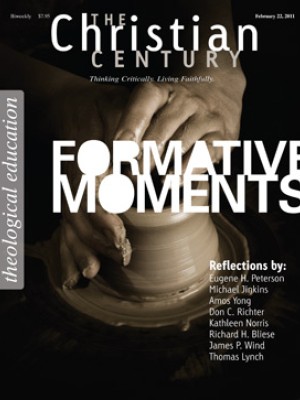Expect a whirlwind
In the film noir classic Sunset Boulevard, Norma Desmond is an aging silent-film star with her pride fully inflated but her glory days well behind her. Early in the movie, a man driving by Norma's crumbling mansion has a flat tire, and he knocks on her door seeking help. When Norma appears, the man's eyes widen with surprise.
"You're Norma Desmond!" he says, astonished. "You used to be in silent pictures. You used to be big!"
Norma raises herself to her full height. "I am big," she says with indignation. "It's the pictures that got small."
Norma's retort may have something to say about current trends in congregational worship. Worship is highly contested real estate these days, what with the wild blossoming of praise songs and hand-waving chants, overamped electric bands and singer-songwriter liturgists strumming acoustic guitars, plasma screens, preachers in sweatshirts and sermons beamed to distant sanctuaries via holograms, not to mention worship spaces jammed with enough klieg lights and projectors to cause power grid brownouts. Some people love the relaxed, upbeat style that seems in ascendance, while others find it showy, commercialized and even irreverent; these are either wistful for the days of pipe organs and vestments or yearn for something new, emerging, yet unborn.
Read our latest issue or browse back issues.
Instead of fretting about style, however, perhaps we should be more concerned about scale. Worship by definition should guide us to a larger place, should direct our gaze away from ourselves and toward the most vast, holy and mysterious of all horizons. But for all the over-the-top extravagance of many worship experiences, for all the invocations to an "awesome God," much worship today seems curiously trivial, inward and downsized. To paraphrase Norma, "The vision of worship is still magnificent; it's the services that got small."
We can see this downsizing in the sometimes trifling use of language. We Americans are involved in two bloody wars, have a rapacious petroleum habit and are near Depression levels of unemployment, but prayers of confession often bemoan banal, relatively low-cost, middle-class transgressions such as "busyness" or "letting our minds wander from You." Reportedly, Martin Luther's confessor became so frustrated when Luther was confessing "puppy sins" that he shouted at Luther, "Go kill your father or something. Then we'll have a sin to talk about!"
For another instance of the diminution of language, take the widely admired Iona hymn "The Summons." Set to a bouncy Scottish tune, it certainly has its charms, but deep in the lyrics it expects us to sing, "Will you love the 'you' you hide if I but call your name? Will you quell the fear inside and never be the same?"
Forget for a moment the tendency of recent hymns to put God's voice in the mouths of the worshipers. Focus instead on the linguistic carelessness. Try saying "the 'you' you hide" three times quickly without giggling. "Will you quell the fear inside and never be the same?" sounds nice until we think about it and realize how superficial this view of the human plight is, how small-scaled and overly optimistic.
In her wonderful book The Bones Reassemble, Catherine Madsen finds a similar trivializing of language in some recent Jewish liturgies. One new prayer book, for example, translates Psalm 122:1 as "I was glad when people said to me, 'Let us journey to the house of THE UNSEEN.'" Madsen reports that one worshiper responded with a Bobbsey Twinsey "Yes, let's do!" and another with an adolescent "Yeah, let's see how many we can fit in the car! You bring the six-pack!"
Some downsizing in worship undoubtedly results from our culture's rampant narcissism. It is easy to sniff out the latent hubris in praise lyrics like "I can only imagine what it will be like when I walk by your side," but some "official" hymnody is hardly exempt from cloying self-reference. A much cherished hymn has the faithful croon, "Here I am Lord. It is I, Lord." Given the hymn's Glee-like musical setting, this usually comes across less like an awestruck Isaiah trembling before God in the temple and more like an ecclesial, "Put me in, coach! I can play centerfield!"
In the final analysis, though, neither clumsy language nor narcissism is mainly to blame for the downsizing of worship. Rather, it is the loss of the expectation of God's presence, or more precisely, God's dangerous presence. George Steiner once commented that he could imagine the author of Hamlet going home to lunch and responding normally to "How did it go today?" But he could not conceive of the author of the speech "out of the whirlwind" in Job "dwelling within common existence and parlance."
Just so, when even tacitly we think of the dramatis personae of worship as "just us," when there is no expectation of the whirlwind, worship becomes small and confining. True worship happens in response to the holy and dangerous mystery of God's appearing. Annie Dillard was right to name liturgy as "certain words which people have successfully addressed to God without their getting killed."
Or to put it in a more modest way, if we genuinely discerned that worship takes place in the presence of the burning bush, would we really spend the time licking the glaze off of a doughnut and sipping a latte?







